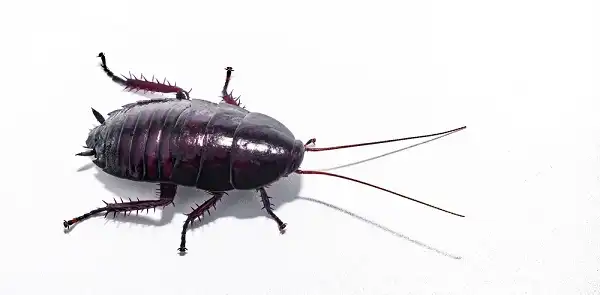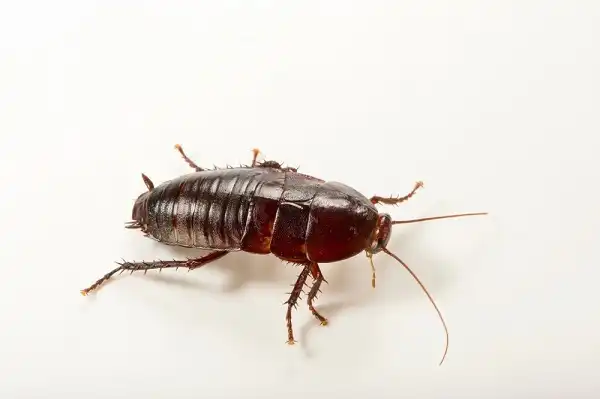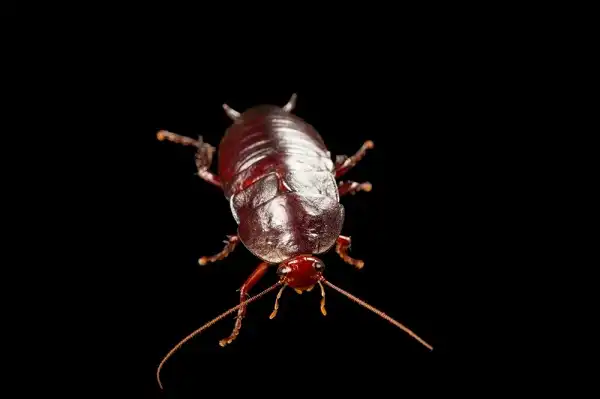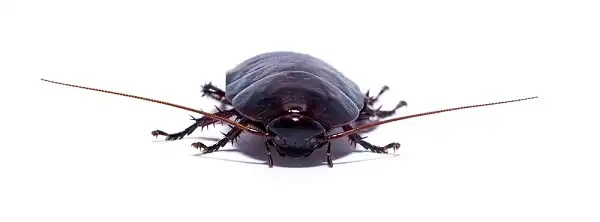If you’ve lived in the Southeast for any length of time, chances are that you’re familiar with the Florida Woods cockroach. This insect is one of the few non-native species to make its way into every corner of our state and can often be seen scrambling across roads or hiding away from predators. Though not as destructive as some other common pest species, these resilient creatures can still cause havoc if they manage to find their way indoors – which is why it’s important to understand a bit more about them before taking action. Today we’ll take an in-depth look at the Florida woods cockroach: where it came from, what makes it so special, and how best to deter them away from your home.

Florida Woods Cockroach Description
The Florida woods cockroach (Eurycotis floridana) is a non-native species that has managed to become ubiquitous throughout the Southeastern United States. Typically found scrambling across roads or hiding from predators, these creatures can cause problems if they find their way indoors. The Florida wood cockroach is not as destructive as some other common pest species, but it’s important to understand its habits and characteristics in order to effectively deter them from your home. They have wings, but rarely if ever fly. Instead, they rely on their strong legs to scurry across the ground or climb up walls. The Florida woods cockroach is often mistaken for the American cockroach but can be distinguished by its dark brown to black body color, which is shiny and smooth. Unlike the American cockroach, which has a distinct pattern of lighter and darker markings on its thorax, the Florida woods cockroach has a uniform appearance.
Florida Woods Cockroach Habitat
The Florida wood cockroach can be found in a variety of habitats, ranging from forests and swamps to suburban and urban areas. They prefer areas with high humidity and ample amounts of decaying organic matter to feed on. In the wild, they can be found living in tree hollows, under loose bark or leaves on the forest floor, and in compost piles. In suburban and urban areas, they can be found in yards, gardens, and mulched areas. They may also find their way inside homes and buildings, especially in areas with high humidity such as basements, kitchens, and bathrooms. Infestations can be especially problematic in multi-family housing complexes or apartment buildings, as they can easily spread from unit to unit. Due to their adaptability, Florida wood cockroaches can thrive in a variety of environments, from coastal areas to inland forests. However, they are more commonly found in the southeastern United States, including Florida, Georgia, and Alabama.
Florida Woods Cockroach Diet
The Florida wood cockroach is a hardy and adaptable insect that can survive in a variety of environments, and one of the keys to its success is its ability to feed on a wide range of organic matter. As opportunistic scavengers, these roaches will eat just about anything they can find, including decaying plant matter, rotting fruit and vegetables, and even dead animals and insects. One interesting fact about the Florida woods cockroach’s diet is that it can subsist on cellulose, a tough carbohydrate found in plant cell walls, thanks to the presence of specialized gut bacteria that break down this otherwise indigestible substance.
This adaptation allows these roaches to feed on tough plant matter that many other species of roaches can’t eat. In addition to cellulose, the Florida wood cockroach will also feed on other types of plant material, including leaves, bark, and fungi. They are also known to feed on carrion, which can include roadkill, dead animals, and even other insects. This scavenging behavior helps the roaches to survive in the wild where food sources may be scarce or unpredictable.

Florida Woods Cockroach Size
The Florida woods cockroach, also known as the palmetto bug, is one of the largest cockroach species found in the United States. Adult females can reach lengths of up to 1.6 inches (4 cm), while males are slightly smaller, measuring around 1.4 inches (3.5 cm). They have flat, oval-shaped bodies and are reddish-brown in color. One notable feature of the Florida Woods cockroach is its wings. While both males and females have wings, they are not strong fliers and can only flutter short distances. In fact, some individuals may not be able to fly at all. In addition to their large size, Florida wood cockroaches are also known for their distinctive antennae. These organs are used to detect odors and vibrations, allowing the roaches to navigate their environment and locate potential food sources.
Florida Woods Cockroach Lifespan
The Florida woods cockroach, also known as the palmetto bug, is a resilient insect known for its large size and varied diet. While they can live in a variety of environments and subsist on a wide range of food sources, one interesting aspect of these cockroaches that often goes overlooked is their lifespan. The Florida woods cockroach has a relatively long lifespan for an insect, with adults living up to 2 years in the wild. This is significantly longer than many other species of cockroaches, which may only survive for a few months. In captivity, Florida wood cockroaches have been known to live even longer, up to 3 years or more. The lifespan of the Florida wood cockroach can be influenced by a number of factors, including environmental conditions, food availability, and genetic traits. Adults that live in habitats with abundant food and water resources may be more likely to live longer than those in more challenging environments.
Florida Woods Cockroach Behavior
The Florida woods cockroach, also known as the palmetto bug, is a fascinating insect with unique behaviors that set it apart from other cockroach species. These large insects are mostly nocturnal and prefer to reside in dark, damp areas such as basements, crawl spaces, and hollow trees. One interesting behavior of Florida wood cockroaches is their use of pheromones to communicate with each other. Male cockroaches will emit a scent to attract females for mating, while females may release a different scent to signal the presence of food or to locate their offspring. In terms of defense mechanisms, Florida wood cockroaches have a few tricks up their sleeve. When threatened, they may emit a foul odor to deter predators or play dead as a last resort. They also have the ability to shed their limbs in order to escape from predators, a process called autotomy. While this may seem extreme, these insects are able to regenerate their limbs over time. Overall, Florida wood cockroaches have a complex and fascinating set of behaviors that allow them to survive and thrive in a variety of environments.

Florida Woods Cockroach Speed
When it comes to speed, the Florida Woods cockroach is not the most impressive insect out there. These large insects are relatively slow-moving, with a top speed of around 1.5 miles per hour. However, their size and ability to navigate rough terrain make them well-suited for survival in their natural habitat. One interesting fact about the Florida woods cockroach’s movement is that they are able to climb vertical surfaces with ease. This is thanks to specialized adhesive pads on their feet that allow them to grip onto surfaces like bark and stone.
Florida Woods Cockroach Hunting
Florida wood cockroaches are opportunistic predators, and their hunting behavior is a critical aspect of their survival strategy. These insects are adept at hunting in both open and closed environments, seeking out potential prey with their keen senses of smell and touch. Their diet primarily consists of other insects, including termites, beetles, and other species of cockroaches. They often hunt in packs, with multiple cockroaches working together to take down larger prey. Their hunting technique involves using their powerful jaws to crush the exoskeletons of their prey, allowing them to consume the soft tissue inside. Florida wood cockroaches have also been known to scavenge for food in human dwellings, often feeding on pet food left out overnight or on other organic matter found in and around homes. While they are not considered harmful to humans, their presence in human dwellings can be a nuisance, and they are often seen as a pest.
Florida Woods Cockroach Reproduction
Florida wood cockroaches reproduce through a process known as “budding”, in which a female lays her eggs in an enclosed environment such as a rotting log or chamber of soil. The mother protects the eggs from predators by covering them with a layer of wax-like material secreted from her body. When the eggs are ready to hatch, the nymphs emerge and quickly scatter out into their surrounding environment. These cockroaches reach sexual maturity after only 2 months. They usually mate during the spring season when food sources are abundant, allowing them to better support their young offspring. The female typically produces several egg cases throughout her lifetime, each containing up to 100 individual eggs.

Conclusion
The Florida wood cockroach is an impressive species with a remarkable ability to survive and thrive in its natural habitat. From their complex communication systems to their defensive strategies, these insects have demonstrated remarkable adaptations over time that make them well-suited for life in the Florida woods. Their impressive hunting behavior helps control populations of other insects, contributing to the overall diversity of the environment. While they may not be the fastest or most glamorous insects out there, Florida wood cockroaches are a fascinating species worthy of respect and admiration.
Frequently Asked Question

